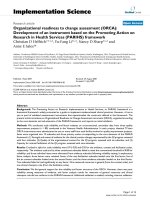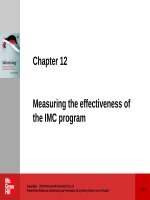Lecture Conducting and reading research in health and human performance (4/e): Chapter 12 - Ted A. Baumgartner, Larry D. Hensley
Bạn đang xem bản rút gọn của tài liệu. Xem và tải ngay bản đầy đủ của tài liệu tại đây (309.2 KB, 21 trang )
Chapter 12
Additional Research
Approaches
Additional Approaches in
Research in HHP
Methods not as prevalent as those previously
presented, but may have application in some
areas of HHP
•
•
•
•
Historical
Epidemiological
Single Participant
Creative Activities
Historical Approach
The researcher attempts to record and
understand events of the past in order to better
explain present events and suggest possible
future directions
Nature of Historical Research
Involves collection of data
Through the eyes of other people who witnessed
an event or wrote about it
Why we do certain things today is based on
what has happened to us in the past
• Need to understand the past
• Discovery of new data/information may lead to new
interpretations
Sources of Historical Data
Primary sources
Secondary sources
Primary sources
Source is directly connected to the event of
interest
Original documents or physical artifacts
People that can provide eyewitness testimony
Highest credibility and preferred data source
Secondary sources
Secondhand accounts of historical happenings
Hearsay evidence . . . person is not directly tied
to event
Textbooks, newspapers, encyclopedias, etc.
Considered less reliable source of data
Evaluating Historical Data
Historical data must be critically evaluated to determine
authenticity and worth
External criticism
• Physical or chemical tests of documents
• Tests of signature, script, and handwriting
• Consistency of language usage
Internal criticism
• Assesses the meaning of the content
• Author’s motives
• Consistency with other reports of same event
Two or more independent sources are needed to verify a
historical fact
Oral History
Oral history research is conducted through
taped interviews with individuals in a position
to recall various events or movements
Oral history information can be very subjective
and opinionated
Strict application of external and internal
criticism should be observed
Biographical Research
Study of the life, career, and contributions of
persons of interests . . . often leading scholars,
coaches, educators, etc.
Often based on extensive personal interviews of
the person of interest supplemented with
interviews of others
Epidemiological Approach
Descriptive epidemiology –
• seeking to identify patterns or trends in disease,
injury, or death
Analytic epidemiology –
• seeking to determine causation of disease, injury, or
death
Common in public health fields
Research Designs
Cohort studies
• a.k.a as prospective studies – a study that begins with
a group of people (a cohort) and follows them over
time
Casecontrol studies
• AKA as retrospective studies – a study comparing a
group who already have a condition of interest to a
group that does not
Case group – the group with the characteristic of
interest (e.g., cancer)
Control group – the group without the
characteristic of interest
Epidemiological Statistics Used
to Measure Strength of an
Association
Relative risk (RR)
Odds ratio (OR)
Attributable risk (AR)
Relative Risk (RR)
The extent to which it is more (or less) likely that
a health problem or condition will occur in an
exposed group compared to an unexposed
group
• RR = 1 no relationship between exposure and condition
• RR > 1 positive relationship; means that those exposed are x
times more likely to contract the condition
• RR < 1 negative relationship; means that those exposed are x
times less likely to contract the condition
Applicable statistic for cohort studies
Odds Ratio (OR)
The most common measure of association
between exposure and health outcome
An estimate of relative risk
• It is the odds of a health problem or condition
occurring in an exposed group (case group)
compared to an unexposed group (control group)
• Interpretation is similar to that of RR
Applicable statistic for casecontrol studies
Attributable Risk (AR)
Index of the percent of cases in the total group
(unexposed group) that occur in the group with a
risk factor (exposed group)
Difference between the incidence rate for the
exposed group minus the incidence rate for the
unexposed group divided by the incidence rate
of the unexposed group
Applicable statistic for cohort studies
Single Participant Approach
a.k.a. “single subject research”
Research conducted on the individual level with
the performance of each research participant,
rather than the group, being analyzed
Behavior or performance of each participant is
evaluated across time with each participant
serving as their own control
Collection and Analysis
The basic approach is to obtain a baseline
measure on the participant, administer a
treatment, then obtain another measure on the
participant
Comparisons are made between the baseline
score and the treatment score
Applied behavior analysis (ABA)
Research Designs
Baseline data are collected (A)
• To ensure a stable measure at baseline, data may be
collected on multiple occasions
• Graphing is useful technique to show data path
Treatment data are collected (B)
• AB design
• ABAB design (more common)
• Others
Nonparametric statistics
Creative Activities
Creative research vs. creative activity
Involves the creation or development of some art
form that is considered new or unique
• Common in dance or fine arts
• Artist, painter, dancer, sculptor, musician, etc.
Evaluation of Creative Activity
Exhibitions or displays
Performances or recitals
Standards for evaluation
•
•
•
•
Judges or critics evaluate
Honors and awards received
Acknowledgments
Receipt of grants









